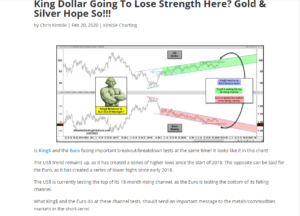While the sell decision is usually one of the more “opaque” and uncertain decisions a portfolio manager can make, (and I can see why some use technical analysis to make that decision for them), the other tough aspect to investing is sitting with non-performers or under-performing sectors or stocks in bull market such as the one we have today.
My frustration with the Emerging Markets ETF(s) is almost painful, as they continue to lag the SP 500, and not without reason.
The China tariff talks and the re-routing of the global supply chain was the first drag on the asset class, Brexit was probably the second drag as the Germany and the UK are the world’s 4th and 5th largest economies, and those economies slowing surely had some tangential impact on the asset class. Finally with the coronavirus outbreak potentially slowing China even more, and the stronger dollar (per CNBC’s Rick Santelli, who tracks the DXY, the US dollar hit a 33-month high this week), the question is how much longer can the asset class be run into the ground without some kind of a bounce.
In terms of my own history with the EM’s, no EM ETF’s were owned until Q1 ’16, when the 10-year “average annual return” on Emerging Markets went negative after a blockbuster decade, between 2000 and 2007, when the EM’s were on fire along with the commodity asset classes like crude oil, gold, coal, fertilizer, etc. etc. However, i avoided the asset class since i felt like it was a trade from the Tech and large-cap momentum of the late 1990’s into another momentum trade of commodities, and EM in the 2000’s. China growing 15% – 16% per year prior to the 2008 Financial Crisis was the catalyst for EM’s to outperform and i learned the “momo” lesson in the early 2000’s.
So fast forward to Q1 ’16 and the 10-year negative return and I felt like at that point EM’s were too cheap to ignore, so a 2% – 3% position was bought and the EEM / VWO ETF combine rose roughly 40% in 2017, helped by the weaker dollar, even though the Fed and Janet Yellen had started to raise rates in Q4 ’15. PIMCO made a very good macro call in Q1 ’16 on the asset class, so it was worth a shot to the long side.
Fast forward to Q1 ’20: here is the compelling aspect to EM’s today: the 10-year “average annual” return of Vanguard’s VWO is 3.64% as of today, versus the SPY’s 14.04%.
Because of the lower-expense ratio of 12 basis points, clients EM exposure has been consolidated into the VWO, whereas into year-end 2109, we had both the EEM and the VWO in client accounts. The EEM has a much higher expense ratio of 68 bp’s versus the VWO, but a lower bid-ask spread. Limit orders are used to acquire positions over time (typically, not always) so you have to consider both when evaluating the cost of an ETF.
What about the dollar ?

Chris Kimble of Kimble Charting Solutions (an excellent technician) published this chart today. Click on the chart to enlarge and note the bottom in early 2018 which we highlighted here in January, 2018. This blog had a good rhythm going with dollar strength / weakness calls, until this recent bout of sustained strength, which has run for 24 – 33 months, when usually you get a reversal after 12 – 18 months.
Summary / conclusion: The VWO is now a top 5 – 6 weight in most client accounts in order to offset some of the momentum seen in the top 3, 5 and 10 market-cap weights in the SP 500, many of which are also owned by clients. While it’s a drag on performance for sure, it prevents the kind of whip-saw rotation that was seen in March, 2000 and during the corrections in this bull market. In fact of you look at the EEM / VWO and how they traded in Q4 ’18, those long saw some out-performance in the asset class during the tough months of October, November, December, 2018.
Although it is always tough discussing politics, I have wondered if the steady dollar strength is a function of a pro-business US President, and the potential for a flip in the House in November, ’20 as a backlash to impeachment, which happened the other way under Clinton in 1998.
All though the House and Senate impeachment process the stock market never reacted to an impeachment headline, and the dollar remained steady. The same wasn’t true at all for trade headlines for 2018 and 2019. Every adversarial trade tweet hammered the indices.
We are sticking with the VWO and the Oakmark International Fund as our primary non-US, non SP 500 large-cap momentum hedge.
It’s painful, but when Joel Greenblatt came through and spoke to the Chicago CFA Society in December ’18, his lesson was you have to be patient and suffer through the under-performance. Here is the summary of his excellent lecture.
Thanks for reading. Just voicing some frustration.
My personal email is brianglm@trinityasset.com if you wish to send comments, criticisms, praise, offers to engage in fisticuffs, etc. whatever you like.
